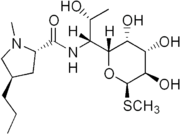
Lincosamides
Encyclopedia


Mechanism of action
Lincosamides kill bacteria by interfering with the synthesis of proteinsProtein synthesis inhibitor
A protein synthesis inhibitor is a substance that stops or slows the growth or proliferation of cells by disrupting the processes that lead directly to the generation of new proteins....
. They bind to the 23s portion of the 50S
50S
50S is the larger subunit of the 70S ribosome of prokaryotes. It is the site of inhibition for antibiotics such as macrolides, chloramphenicol, clindamycin, and the pleuromutilins. It includes the subunits 5S and 23S.-Structure:...
subunit of bacterial ribosome
Ribosome
A ribosome is a component of cells that assembles the twenty specific amino acid molecules to form the particular protein molecule determined by the nucleotide sequence of an RNA molecule....
s and cause premature dissociation of the peptidyl-tRNA from the ribosome. Lincosamides do not interfere with protein synthesis in human cells (or those of other eukaryotes) because our ribosomes are structurally different from those of bacteria.
History and uses
The first lincosamide to be discovered is lincomycin, isolated from Streptomyces lincolnensis in a soil sample from Lincoln, Nebraska (hence the bacterial name).Lincomycin has been superseded by clindamycin, which exhibits improved antibacterial activity. Clindamycin also exhibits some activity against parasitic protozoa
Protozoa
Protozoa are a diverse group of single-cells eukaryotic organisms, many of which are motile. Throughout history, protozoa have been defined as single-cell protists with animal-like behavior, e.g., movement...
, and has been used in toxoplasmosis
Toxoplasmosis
Toxoplasmosis is a parasitic disease caused by the protozoan Toxoplasma gondii. The parasite infects most genera of warm-blooded animals, including humans, but the primary host is the felid family. Animals are infected by eating infected meat, by ingestion of feces of a cat that has itself...
and malaria
Malaria
Malaria is a mosquito-borne infectious disease of humans and other animals caused by eukaryotic protists of the genus Plasmodium. The disease results from the multiplication of Plasmodium parasites within red blood cells, causing symptoms that typically include fever and headache, in severe cases...
.
They are normally used to treat staphylococci and streptococci, and have proved useful in treating Bacteroides fragilis and some other anaerobes. They are used in the treatment of Toxic Shock Syndrome
Toxic shock syndrome
Toxic shock syndrome is a potentially fatal illness caused by a bacterial toxin. Different bacterial toxins may cause toxic shock syndrome, depending on the situation. The causative bacteria include Staphylococcus aureus and Streptococcus pyogenes...
and thought to directly block the M protein
M protein
M protein may refer to:* M protein ', a virulence factor of the bacterium Streptococcus pyogenes* Another name for paraprotein, an abnormal protein in the urine or blood, often seen in multiple myeloma or MGUS...
production that leads to the severe inflammatory response.
Resistance
Target bacteria may alter the drug's binding site (similar to resistance found in macrolides and streptogramins). The resistance mechanism is methylation of the 23s binding site. If this occurs then the bacteria are resistant to both the macrolides and the lincosamides. Also, enzymatic inactivation of clindamycin has been described (rare).Formulation
The lincosamides, as the hydrochloride salt, are bitter to taste, so for oral formulation they are given as the palmitatePalmitic acid
Palmitic acid, or hexadecanoic acid in IUPAC nomenclature, is one of the most common saturated fatty acids found in animals and plants. Its molecular formula is CH314CO2H. As its name indicates, it is a major component of the oil from palm trees . Palmitate is a term for the salts and esters of...
ester
Ester
Esters are chemical compounds derived by reacting an oxoacid with a hydroxyl compound such as an alcohol or phenol. Esters are usually derived from an inorganic acid or organic acid in which at least one -OH group is replaced by an -O-alkyl group, and most commonly from carboxylic acids and...
s, or formulated in capsules. Clindamycin is given intravenously as clindamycin phosphate, which is then converted into active clindamycin within the body.
Pharmacodynamics
These are bacteriostatic drugs and antagonists of macrolides and streptogramins.Further reading
- Van Bambeke F. Mechanisms of action. In Armstrong D, Cohen J. Infectious diseases. Mosby, London, 1999, pp7/1.1-7/1.14

